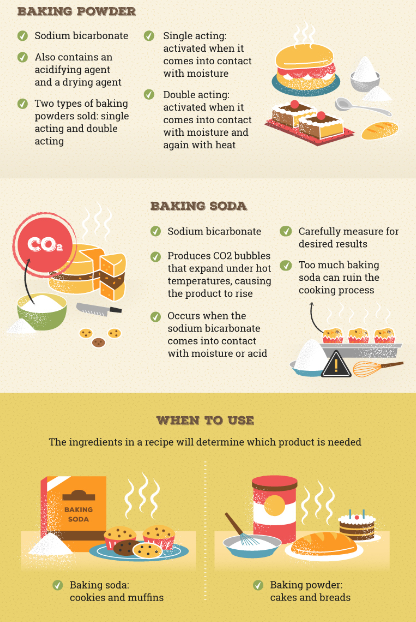BOURSESSENEGAL – When it comes to baking, understanding the difference between baking powder vs. baking soda can significantly impact your culinary results. Both ingredients are leavening agents, but they serve distinct purposes in recipes. Knowing how to use them correctly will ensure your baked goods rise perfectly and taste delicious. In this article, we’ll explore what each ingredient is, their differences, and when to use each one.
What Is Baking Soda?
Baking soda, also known as sodium bicarbonate, is a white crystalline powder. It acts as a leavening agent by producing carbon dioxide gas when it reacts with an acid. This reaction causes dough or batter to rise.
How Baking Soda Works
To activate baking soda, you need an acidic ingredient in your recipe. Common acids include vinegar, lemon juice, buttermilk, or yogurt. When you mix baking soda with these acids, the chemical reaction creates bubbles that help your baked goods rise.
Common Uses of Baking Soda
Baking soda plays a vital role in various recipes. Here are some common uses:
- Cookies: It gives cookies a chewy texture and helps them spread.
- Cakes: It ensures that cakes rise well and become fluffy.
- Quick Breads: In recipes like banana bread or soda bread, it provides leavening without requiring yeast.
What Is Baking Powder?
Baking powder is a combination of baking soda, an acid (usually cream of tartar), and a moisture-absorbing agent (like starch). Unlike baking soda, baking powder contains its own acid, so it doesn’t require an additional acidic ingredient to work.
Types of Baking Powder
There are two main types of baking powder:
- Single-acting: This type releases carbon dioxide gas when mixed with liquid, so you need to bake the batter immediately after mixing.
- Double-acting: This is more common and releases gas in two phases: once when mixed with liquid and again when exposed to heat. This gives you more flexibility in baking.
Common Uses of Baking Powder
Baking powder is suitable for recipes that don’t include additional acidic ingredients. Some examples include:
- Pancakes: It creates light, fluffy pancakes without needing yogurt or buttermilk.
- Cakes: Baking powder helps cakes rise evenly and maintain their structure.
- Muffins: It ensures that muffins have a tender crumb and rise nicely.
Key Differences Between Baking Powder and Baking Soda
Now that we understand what each ingredient is, let’s explore the key differences between baking powder and baking soda.
1. Composition
The primary difference lies in their composition. Baking soda consists solely of sodium bicarbonate, while baking powder contains sodium bicarbonate along with an acid and a stabilizing agent.
2. Activation
Baking soda requires an acidic ingredient to activate, while baking powder contains its own acid and can work without additional acidic components. This makes baking powder more versatile in recipes.
3. Taste
Baking soda has a slightly salty taste, which can be noticeable in recipes if not balanced with enough acid. On the other hand, baking powder is neutral in flavor, making it less likely to alter the taste of your baked goods.
4. Strength
Baking soda is more potent than baking powder. Typically, you need to use about three times as much baking powder to achieve the same leavening effect as baking soda. This difference is crucial when substituting one for the other.
When to Use Baking Soda
Baking soda shines in recipes that include acidic ingredients. Here are some tips on when to use baking soda:
1. Recipes with Acids
Use baking soda in recipes that contain natural acids. Examples include:
- Chocolate recipes: The acidity in cocoa powder activates the baking soda.
- Buttermilk pancakes: The buttermilk provides the necessary acid.
2. For a Chewy Texture
In cookie recipes, baking soda helps create a chewy texture. It’s the go-to choice for chocolate chip cookies and similar treats.
3. Quick Breads
Use baking soda for quick breads that rely on acid for leavening, like banana bread. The interaction with the banana’s natural acidity helps the bread rise.
When to Use Baking Powder
Baking powder is ideal for recipes that do not include additional acidic ingredients. Here’s when to choose baking powder:
1. Balanced Recipes
If your recipe does not contain acids, such as cakes or muffins that rely solely on baking powder, use it for proper leavening.
2. For Light and Fluffy Baked Goods
Choose baking powder when you want a light, airy texture in your baked goods. Pancakes and muffins benefit from the dual-action nature of double-acting baking powder.
3. Convenience
Baking powder offers convenience since it doesn’t require additional acidic ingredients. If you’re in a pinch, baking powder can simplify the baking process.
Substituting Baking Powder and Baking Soda
While baking soda and baking powder are not interchangeable, you can substitute one for the other with some adjustments. Here’s how:
Substituting Baking Soda for Baking Powder
If you need to substitute baking soda for baking powder, you can do so by adding an acid. Use 1/4 teaspoon of baking soda for every teaspoon of baking powder, and add 1/2 teaspoon of an acidic ingredient, such as vinegar or lemon juice.
Substituting Baking Powder for Baking Soda
When substituting baking powder for baking soda, use about three times the amount. So, if a recipe calls for 1 teaspoon of baking soda, use 3 teaspoons of baking powder. However, you may need to adjust for taste since baking powder is less potent.
Conclusion: Mastering Baking Powder and Baking Soda
Understanding the differences between baking powder vs. baking soda can elevate your baking skills. Knowing when to use each ingredient will help you achieve the best texture and flavor in your baked goods.
Remember, baking soda needs an acid to activate, while baking powder contains its own acid. Choose the right leavening agent based on your recipe, and don’t hesitate to experiment. With practice, you’ll master the art of baking, ensuring that your treats rise beautifully every time. Happy baking!
baking powder vs baking soda
REFERENCE : https://www.health.com/



